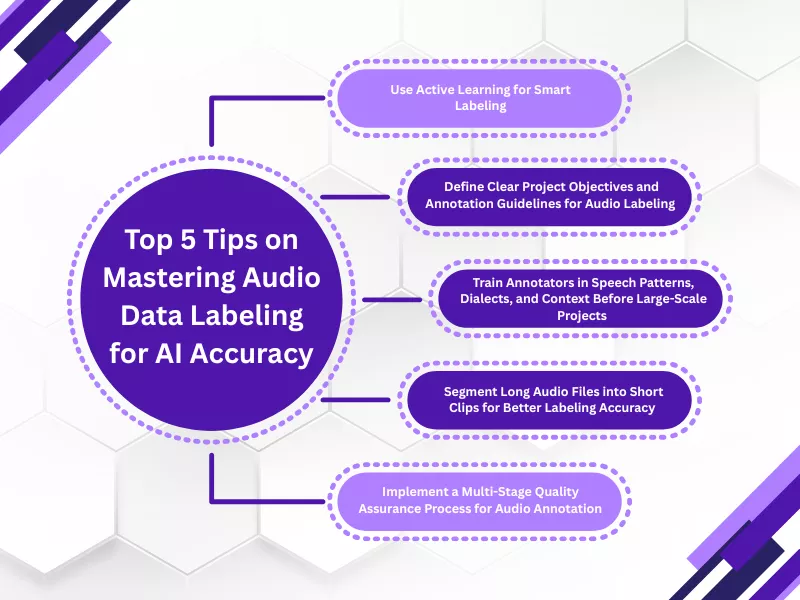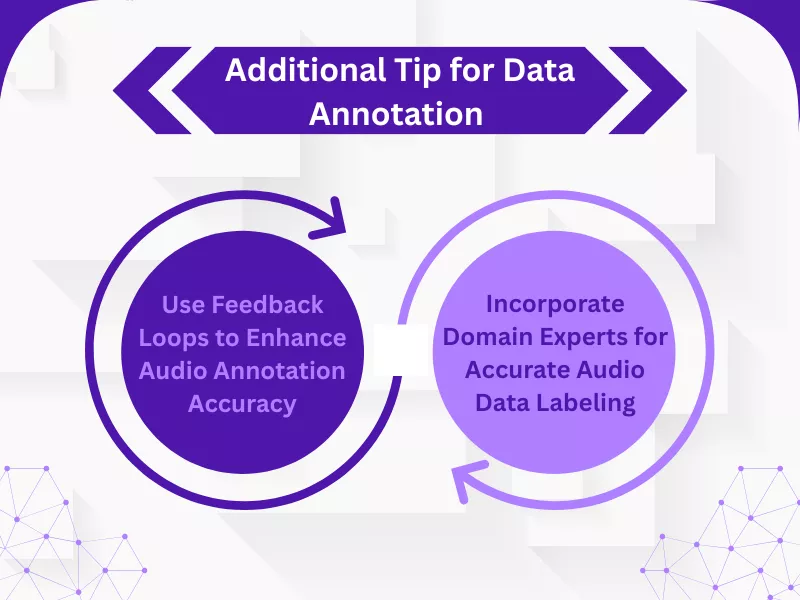Audio annotation is a specialized branch of data annotation that focuses on labelling components of audio data. During the annotation process, annotators like you work with formats such as MP3, FLAC, and AAC to ensure consistency and accuracy across datasets. It’s vital in fields such as speech recognition, voice assistance, etc.
Audio annotation needs both human expertise and specialized annotation software to create high-quality training data. The data annotation will reach $10.67 billion by 2025 with a CAGR of 8.3% through 2033. Unfortunately, the pain point is that approximately 30% of the sound categories lack reliable labels.
If you are an audio annotator who is eager to master audio data labelling and improve AI model accuracy, then this is the perfect place for you. In this blog, we’ll explore 5 powerful techniques on how to Master Audio Data Labeling for AI Accuracy.

Use Active Learning for Smart Labeling
Are you working on Speech recognition labeling? Then active learning can be the best option for you. In addition, it smartly integrates human-in-the-loop annotation services to create efficient, high-quality labeled audio data. It also helps audio annotation companies to maintain Quality assurance.
Major Benefits of Implementing Active Learning in AI Systems?
By using machine learning models, you will be analyzing large-scale datasets of audio files. After this, you can highlight which sound events and spoken words are most uncertain or misclassified. In addition, this system then prioritizes audio recordings for manual review, where experts like you will have the greatest impact on learning models.
For example, active learning will ensure experts like you spend time on the few hundred clips that are confusing the model, rather than wasting time listening to a million clear examples of “Hi, how are you?”. Therefore, leading to faster, cheaper, and higher-quality model improvement. As a final point, this method is valuable for large-scale data collection and projection of labeling.
Define Clear Project Objectives and Annotation Guidelines for Audio Labeling
Defining clear project objectives and annotation guidelines is vital for creating high-quality labeled data that powers accurate AI systems. In addition, understanding exact sound events, emotional tones, and speech patterns makes your workflow smoother and more efficient.
Top Reasons Why Clear Project Guidelines Ensure Good Quality of Audio Annotation
Making a clear objection helps annotation and transcription services maintain strong quality control across large-scale projects :
- Annotators can transcribe human speech and identify speaker details. With this, you can detect subtle elements such as background noise, accents, and emotions. This precision ensures that deep learning models can effectively learn from the labeled data they are used to train on.
- Well-defined guidelines reduce confusion while dealing with diverse audio types. This leads to consistent annotations that support better sound event detection.
Last but not least, strong project definitions and annotation standards allow teams to build accurate transcription datasets. These datasets improve AI performance in applications ranging from emotion detection to speaker identification. Therefore, ensuring smarter, more responsive systems built on precise audio data annotation.
Train Annotators in Speech Patterns, Dialects, and Context Before Large-Scale Projects
Before delving into a big audio annotation project, do not forget to train annotators in speech patterns, dialects, and real-world context. In addition, this early preparation will reassure your team that professionals can handle complex audio samples with confidence and precision.
Why Is It Best to Create Comprehensive Audio AI Annotation?
- This will help with AI data annotation, as professionals can turn spoken words into text if they understand how accents, tone, and emotion vary across speakers.
- In addition, this proper understanding helps produce structured data, which is essential for training reliable AI and machine learning models.
- Well-trained annotators in a team will ensure that data used to train models is clear, context-rich, and ready for high-performance AI applications such as voice assistants, language learning, and audio classification.
Bonus Tip for training data
In the Advanced Audio Labeling Best Practices, experts are needed. So follow these to ensure smooth work from experts: Effective training should include comprehensive audio examples and real-life training material from an experienced annotation partner.
This helps build both efficiency and accuracy while maintaining robust quality throughout every step of the project. Last but not least, even with the best data annotation tools, human expertise remains key to ensuring quality, maintaining accuracy, and preventing labeling errors.
Segment Long Audio Files into Short Clips for Better Labeling Accuracy
Have you ever tried labelling one long audio file and got tired? Well, you’re not alone as labeling a long audio file without segmentation can lead to mistakes. So, instead, try to make segmentation as much as possible! Segmenting or splitting long sound files into shorter clips makes a huge difference. In addition, it helps experts stay focused and annotate AI data with accuracy and efficiency.
Why Does It Help to Annotate Properly?
This step is very important, especially when you’re working with machine learning audio datasets.
- It will give you better focus and fewer mistakes, as shorter clips are easier to listen to and label correctly. As a professional, you can pay more attention to small details like background noise, tone, or emotion without getting exhausted.
- You will get more accurate labels by dividing the audio into parts. The reason behind this is that you can catch changes in speech patterns, dialects, or overlapping conversations more easily.
- It will also improve your quality control, as smaller clips make it easier for you to double-check each annotation for accuracy and consistency.
- Segmentation helps automate pre-labeling and lets AI flag uncertain clips for human review. Therefore, speed up your annotation cycles.
Think of segmentation as breaking a big problem into small, manageable tasks. It helps you create cleaner and detailed machine learning audio datasets. It is making your AI data annotation process faster, more accurate, and far less stressful. So next time you start labeling, don’t go for the marathon; instead, split your audio into short sprints.
Implement a Multi-Stage Quality Assurance Process for Audio Annotation
When you’re building AI projects that rely on annotated audio, it’s not enough to just label data at once and move on. You need to ensure that your team uses this step.
In simple terms, the labeled data must be reviewed multiple times by both humans and AI tools before being used for model training. This process ensures that your AI learns from data that’s not only labeled but also accurately labeled. A human-in-the-loop approach must be used while conducting any kind of audio annotation.
Read the sample case study to know how it works. From the above discussion, efficient audio annotation requires proper multi-stage QA. Different types of mistakes in specific annotations are detected more quickly.
How Does It Help an Annotation Service?
- In a multi-stage QA, it standardized the labelling of audio and speech. This is essential in fields like speech recognition for maintaining quality and an efficient annotation process.
- This step will also help to improve accuracy, therefore leading to a more reliable model for speech recognition.
- Early error detection makes large-scale audio annotation projects more efficient. Also, it reduces rework and maintains data security throughout all annotation stages.
- Also, a Python-based script or AI models can perform rule-based checks to identify missing or inconsistent data in a shorter time.
Finally, this blend ensures technical accuracy while maintaining data security, as human reviewers follow strict confidentiality protocols alongside automated systems.
Additional Best Practices for Data Annotation

Use Feedback Loops to Enhance Audio Annotation Accuracy
If you want to get better at audio data labelling, feedback loops are one of the smartest tools you can use. Consider a feedback loop as a continuous learning cycle: you’ll label data, receive feedback, and make the necessary improvements. Hence, over time, your work will become more accurate, efficient, and consistent.
Catch and Fix the Mistakes Faster
When professionals can flag confusing or unclear audio clips, proper feedback will help them make necessary corrections before they make any mistakes in the audio. This means that your labelled data that goes into your AI model will be more reliable. Ultimately, it will improve sound labelling for AI Accuracy.
Continuous Learning and Growth
Audio Transcription Services are not a “do it once and forget task. With a proper feedback loop, it keeps the process alive and evolving. In addition, it will also help your team to manage critical challenges like new accents, languages, or sound environments. By working in a loop of feedback and correction, you don’t just label data; you build better Smart Models that understand sound more accurately.
Incorporate Domain Experts for Accurate Audio Data Labeling
Boost your annotation accuracy and model reliability by using domain experts. These experts have specialized knowledge, experience, and contextual understanding.
Key Benefits for accuracy in AI models
- Domain experts are skilled at distinguishing subtle speech recognition, technical jargon, and context-specific signals. In addition, these qualities are essential for accurate labeling in fields such as medical transcription and sentiment detection.
- Research indicates that involving domain experts raises annotation accuracy by 30% on specialized speech and audio tasks. Therefore, making this investment is strategic for advanced AI projects.
- Taking support from domain experts actually helps reduce annotation drift and bias.
Workflow Setup for Efficient Audio Data Labeling in 2026
A well-structured workflow ensures that audio annotation projects remain efficient, accurate, and scalable. The following components are essential for building a strong and reliable annotation workflow:
Well-Defined Annotation Pipeline
A stage-wise pipeline helps annotators understand their responsibilities at each point. A typical pipeline may include segmentation, tagging, transcription, event identification, and timestamping, therefore marking each handled by trained specialists.
Documentation and Performance Tracking
Maintaining documentation such as guidelines, checklists, and error logs helps teams stay aligned. Tracking annotator performance ensures that consistent quality is maintained throughout long-term projects.
Scalable Infrastructure
As datasets grow, the workflow should scale without slowing down. Cloud-based platforms, distributed teams, and collaborative dashboards enable smooth expansion for large AI projects.
Key Challenges in Audio Data Labeling
In this section of the blog, we will discuss the challenges that annotators face :
- Handling Ambiguity: Audio clips frequently contain unclear speech, background noise, or indistinct sounds, making it difficult for annotators to confidently identify what is being said.
- Dealing with Diverse Accents: Global audio datasets include speakers with a wide variety of accents, dialects, and pronunciation patterns, which can lead to misunderstanding or inconsistent labelling.
- Managing Large-Scale Projects: As projects grow, keeping track of thousands of files, multiple annotators, and varying label types becomes increasingly complex and prone to oversight.
- Balancing Speed and Accuracy: Deadlines often push annotators to work faster, but speed increases the risk of errors, creating tension between completing work quickly and maintaining high-quality labels.
Best Institutions in the USA where Annotators can learn: A guide to Annotators
Planning to work in the annotation field? Do not worry, as with an in-depth analysis, we have found some of the best institutions where you can join:
- DeeLab Academy
- label visor
- Hypothesis academy
- Orchvate.
Wrapping Up
Mastering audio data labeling isn’t just about tagging sounds; it’s about training your ears and mind to hear what AI can’t yet understand. By following these strategies, starting from segmentation to feedback loops, you’ll not only improve labeling accuracy but also help build smarter, more human-like AI systems in the future of audio annotation.
In the end, learning audio annotation techniques can help you excel in your future career. Keep learning, stay curious, and remember: every sound you label brings machines one step closer to truly understanding the world of audio.
Frequently Asked Questions
What are the biggest challenges in labeling noisy or overlapping audio data for AI?
Noisy or overlapping audio makes it hard to identify speakers, sounds, and emotions. Background noise, cross-talk, and unclear speech reduce labeling accuracy and require advanced filtering or expert annotators.
How do automated pre-labeling tools support human annotators in audio projects?
Automated pre-labeling tools speed up the process by detecting speech segments, speakers, and keywords. They give annotators a starting point, reducing manual effort and improving overall consistency.
What are the most common mistakes beginner annotators make in audio data labeling?
Beginners often mishear words, ignore timestamps, label emotions inaccurately, or follow inconsistent guidelines. Lack of context and poor attention to detail also cause errors.
How can emotion or sentiment be accurately labeled in speech data?
Accurate emotion labeling requires focusing on tone, pitch, pauses, and context. Using clear guidelines, multiple annotators, and validation checks improves reliability.
What are the ethical concerns or data privacy rules in audio annotation?
Annotators must follow strict privacy laws like GDPR, anonymize personal details, and avoid sharing sensitive audio. Consent, secure storage, and restricted access are essential.
Which software platforms or tools are best for large-scale audio annotation projects?
Top tools include Labelbox, Amazon SageMaker Ground Truth, Audacity, and Prodigy. They offer scalable workflows, audio segmentation features, and quality controls.
How can multi-language or multilingual audio datasets be labeled effectively for AI?
Use native language annotators, provide language-specific guidelines, and segment audio clearly. Tools with multilingual support ensure accuracy across accents and dialects.
What metrics should you track to measure annotation quality in audio datasets?
Key metrics include accuracy, consistency, inter-annotator agreement (IAA), and error rate. These help measure reliability and reduce labeling bias.
How do you balance speed and accuracy in large audio labeling projects?
Use pre-labeling tools, clear guidelines, batch processing, and quality checks. Automating simple tasks allows annotators to focus on complex segments.
Can crowd-sourced annotation be reliable for audio data labeling?
Yes, with proper training, guidelines, and quality control. Using multiple reviewers and validation steps ensures reliable crowd-sourced audio labels.
- How to Master Audio Data Labeling for AI Accuracy in 2026 - November 18, 2025
- The Importance of Data Security in E Commerce Audio Annotation - October 30, 2025
- Improving Podcast and Media Transcriptions with AI-Based Audio Annotation - September 12, 2025






